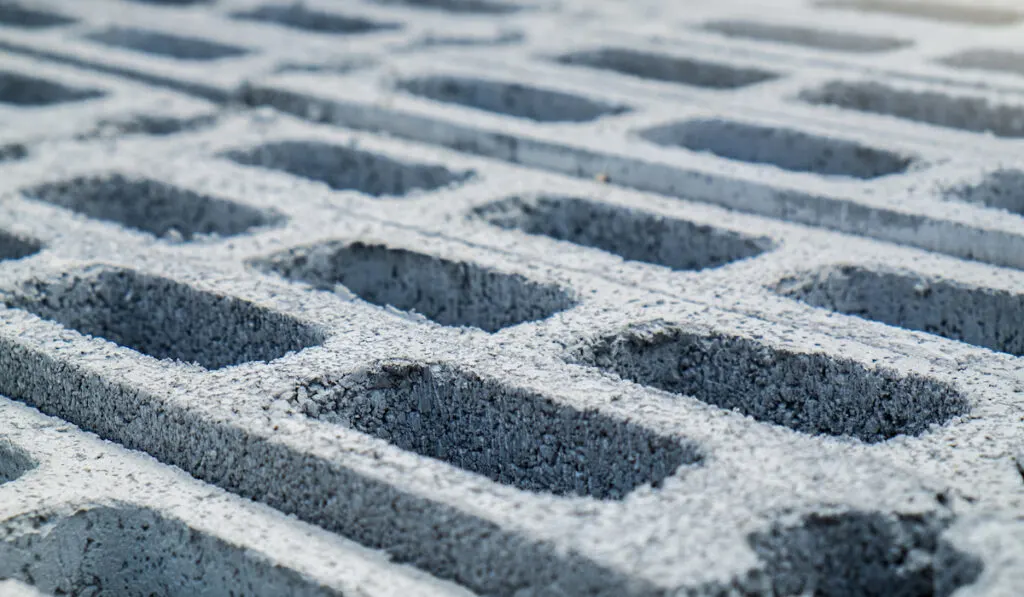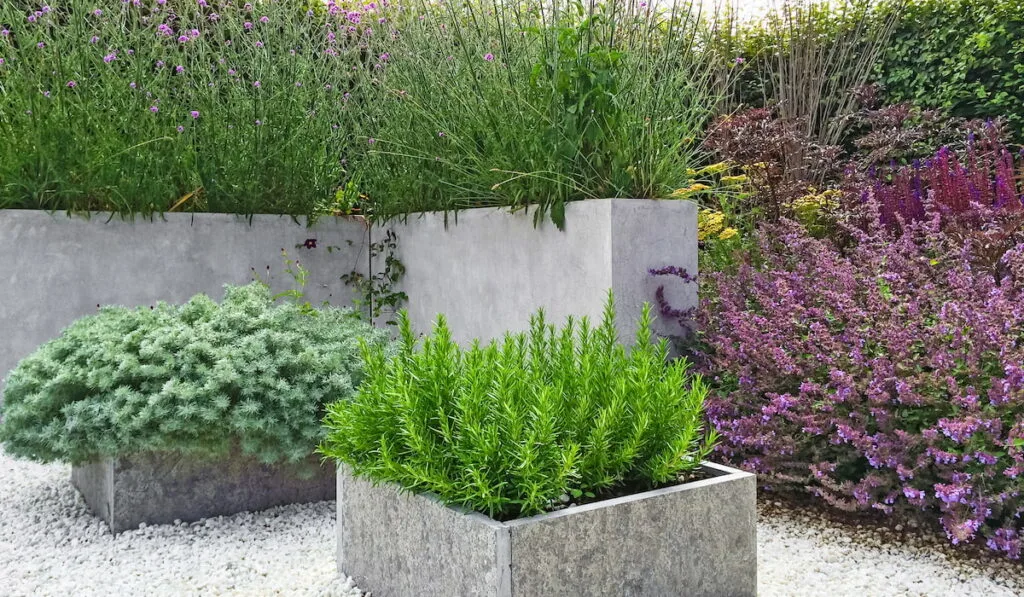There is no need to worry about using concrete blocks to build raised garden beds. There have been claims that the materials used to make the concrete blocks have harmful chemicals that may leach into the soil potentially damaging or even contaminating crops. However, there is no “concrete” proof of that.
Of course, if this is something you are truly concerned about, you can opt to paint the concrete blocks to prevent them from coming into contact with the soil and plants.
Alternatively, you can line the raised garden bed with plastic as is done for many other materials when necessary. But, is any of this necessary?
The most advantageous thing about concrete blocks is that they keep the soil in place. In addition to that, the holes at the top of the blocks can be used as planters if filled with soil. The holes can also offer support to fencing structures such as fencing posts.
Table of Contents
Differences Between a Concrete Block and a Cinder Block
Cinder block is also comprised of concrete material. But it has an extra material, cinder, in it. That makes it very light for building.
Concrete and cinder blocks are two different structural elements that are always confused with each other.
| Cinder block | Concrete block |
| Ash is used as an aggregate | Ash is used to build wall units |
| Made of concrete and cinder | Made from wood, steel or cement |
| Lighter in weight than concrete blocks | Heavier in weight because it has stone and sand in it |
| Cannot withstand high pressure | Has high strength to withstand high pressure |
| It is flexible so not recommended for structural support | It is strong enough to be used in any structure |
| Used often in small projects such as garden walls | Used more often in large and important construction projects. |
| It is ancient and old-fashioned | Used more often in the modern world due to its strength. |
| It is expensive to maintain because it requires a lot of repairs. | Cheap and requires no repairs. |
What Are Concrete Blocks Made Out Of?

Concrete blocks are made from cast concrete like Portland cement and aggregates usually sand and fine gravel for high density blocks. A chemical reaction takes place when the two ingredients are mixed and concrete is formed.
Lower density blocks may contain ash and industrial wastes.
What Are Cinder Blocks Made Out Of?
Cinders are made from burned coal ash and cinder in some of the aggregates mixed with concrete.
Ways to Protect Soil From Chemicals
Any time you are worried about your garden bed walls leaching chemicals into the soil, there are a variety of options you can choose from to seal the garden wall or create a barrier between the wall and the soil.
Paint and plastic garden bed liners are the two most common items used.
Sealing Blocks with Paint
Seal the blocks using paint to minimize their contact with soil and to reduce the potential risks of leaching chemicals into the soil.
There are a wide variety of paints available to paint concrete blocks. Each has it’s pros and cons as far as durability and effectiveness. Check out our article about painting raised garden beds for more information.
Using a Liner
Apply a thick plastic liner or a polypropylene fabric between the concrete blocks and your garden soil to give room for drainage.
There are a wide variety of liner materials available on the market. Be sure and check out our post on liners for more information on the different types.
Step by Step Guide to Building a Raised Bed Out of Concrete Blocks
Supplies needed are:
- Concrete cinder blocks
- String
- Level
- Square
- Rebar for Corners (optional)
- Soil/media
- Paint (optional)
- Tape measure
- Working gloves
Step 1- Arrange/ display your concrete block raised bed design
Lay out your bed design so that everything fits in your planned space. Wear gloves when moving blocks around because the blocks are heavy.
You really have a lot of leeway here. One thing to keep in mind, though, is that if you plan on working in the garden for weeding or to harvest vegetables, you want to have it no more than 3 – 4 feet wide.
Think about how difficult it will be to lean over and access or work on plants at the middle or farthest point in the garden.
Step 2- Make Sure Your Lines are Straight and Your Corners Square
Use a string to make sure the blocks are arranged on a straight line. You can then mark the line using paint to ensure everything is kept in line.
The last thing you want is to step back to admire all of your hard work and see that the beds are crooked. Trust me, once you see it you won’t unsee it.
Step 3- Remove Grass Under the Blocks
It is a good idea to remove the grass if your working area is not flat. However, if the area is flattened, you can skip this step. Removing grass will enable the blocks to stay in place.
Most raised beds should have walls buried slightly underground when possible to discourage rabbits, squirrels and other diggers from trying to gain access.
Step 4- Fill the Beds with Soil
The great thing about using blocks is that when it comes time to fill the beds with soil, you can simply remove one column of blocks to act as an entrance for your working tools.
This way you can easily use a wheelbarrow to carry the soil directly into the bed instead of dumping soil over the concrete blocks.
Fill the holes between the blocks with soil so that they do not move around.
Fill the garden beds with good quality soil that is pest and disease free.
Step 5- Plant your Concrete bBed
Plant your desired crops and be sure to provide enough water to prevent the plants from wilting.
Remember to add soil after a few weeks because the first soil will settle down and compact over the first week or two.

The Cost of Building a Concrete Block Raised Bed
Constructing a concrete block raised bed is expensive if not careful. However, a concrete bed could be cheap if you want to. One block costs approximately $1. This however does not include the cost of soil.
Your ultimate cost is going to depend on how many blocks you use. Your average cinder block is 8″ wide by 16″ long.
Using this value, you can calculate how many blocks you would need for your project. Multiply that by your cost per block and you’ll have a good estimate for your total cost.
Don’t forget to factor in other expenses though. In addition to the blocks you may need to buy a liner, paint, soil, seeds and more. All of this will add to your total cost so be sure to account for it.
Concrete Raised Garden Bed Size
The length and width of your garden is determined by the size of the blocks and the garden.
Do not construct a bed that will be strenuous for you to access the center from either sides to avoid stepping on the soil which causes compaction.
You can limit the width to four feet or three if you can only access your bed from one side. Several garden beds range from six to twelve inches high. Others could be as high as 32 inches. The deeper the bed, the more the room for root growth.
Number of Blocks Needed
Due to the same block size, it is easy to determine the number of blocks needed for your garden.
For instance, a 4 x 8 inch bed will require 16 blocks to construct each level. Cinder blocks are usually around 8″ tall so if you wanted your bed 32″ tall you would need to build up four rows of block.
A 4′ x 8′ concrete block garden bed takes approximately 16 blocks per layer. 64 total blocks are needed to build an raised garden bed approximately 32 inches high.
Cost estimate to Fill a 4’X8’ Raised Concrete Garden Bed
The prices of the items will depend on the size of your concrete garden.
Media, especially the soil-less one, is expensive because it contains additives and it is sterilized. Keep an eye out for ads for free topsoil on your local community boards or websites like Craigslist.
If you are willing to wait and do a little research, you may be able to get great soil at no cost.
For a 4 x 8 raised bed
- 4 bags of topsoil are needed
- 2 pails of coconut coir
- 2 bags of manure
- 2 inches of shredded leaves.
Filling the Blocks to Retain Soil
There is no cause to worry when you are located in a region that does not encounter freezing temperatures. Extremely low temperatures can cause moisture problems which may burst the blocks.

However, filling the blocks with soil provides additional space growing plants and the soil can help the blocks avoid extreme temperature changes as well.
Conclusion
Using concrete blocks has advantages including:
- Walls are strong as compared to any other building material.
- You can fill the blocks holes with soil and use them as planters.
- They act as barriers to natural and/or manmade disasters.
- They also help in containing soil to prevent it from spreading all over the yard.
However, on the negative side, dealing with concrete blocks requires a lot of learning and practice and may take longer to complete the building process as compared to other materials.
Resources
- https://www.globmac.com/en/cinder-block-vs-concrete-block
- https://extension.umd.edu/hgic/topics/materials-building-raised-beds
- https://getbusygardening.com/concrete-block-raised-bed/
